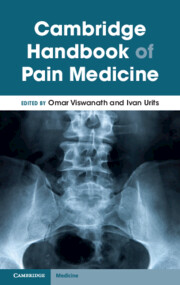Book contents
- Cambridge Handbook of Pain Medicine
- Cambridge Handbook of Pain Medicine
- Copyright page
- Contents
- Contributors
- Pain Handbook Introduction
- Part I Introduction to Pain: Pain Signaling Pathways
- Part II Common Categories of Pharmacologic Medications to Treat Chronic Pain
- Part III Chronic Pain Conditions Head and Neck
- Part IV Spine
- Part V Extremities
- Part VI Misc
- Part VII Adjunctive Therapy
- Chapter 39 Neuromodulation
- Chapter 40 Regenerative Medicine
- Chapter 41 Cognitive Therapy
- Chapter 42 Alternative Therapy
- Chapter 43 Role of CBD in Chronic Pain
- Index
- References
Chapter 40 - Regenerative Medicine
from Part VII - Adjunctive Therapy
Published online by Cambridge University Press: 01 December 2023
- Cambridge Handbook of Pain Medicine
- Cambridge Handbook of Pain Medicine
- Copyright page
- Contents
- Contributors
- Pain Handbook Introduction
- Part I Introduction to Pain: Pain Signaling Pathways
- Part II Common Categories of Pharmacologic Medications to Treat Chronic Pain
- Part III Chronic Pain Conditions Head and Neck
- Part IV Spine
- Part V Extremities
- Part VI Misc
- Part VII Adjunctive Therapy
- Chapter 39 Neuromodulation
- Chapter 40 Regenerative Medicine
- Chapter 41 Cognitive Therapy
- Chapter 42 Alternative Therapy
- Chapter 43 Role of CBD in Chronic Pain
- Index
- References
Summary
Stem cells are a type of cell that can renew themselves and develop into multiple cell types. They are crucial in the formation of tissues and organs and have been studied for use in regenerative medicine. Stem cells can be categorized based on their ability to differentiate, and can be obtained from various sources, including bone marrow, adipose tissue, amniotic cells, umbilical cord, and placental tissue. Platelets are essential for wound healing and maintaining a balance in the body, due to their high concentration of growth factors. Platelet-rich plasma (PRP) has been found to be beneficial for healing soft tissue, bone regeneration, and vascularization of grafts. Research has shown that the optimal therapeutic platelet concentration is four to six times higher than in whole blood. Growth factors like PDGF and TGF-β, which are released by PRP, are linked to cellular remodeling and tissue repair, promoting cell proliferation, matrix synthesis/repair, and nucleus pulposus survival. Autologous PRP therapy is a cost-effective alternative to growth factor injections, making it more accessible to patients in need.
Keywords
- Type
- Chapter
- Information
- Cambridge Handbook of Pain Medicine , pp. 327 - 331Publisher: Cambridge University PressPrint publication year: 2023



